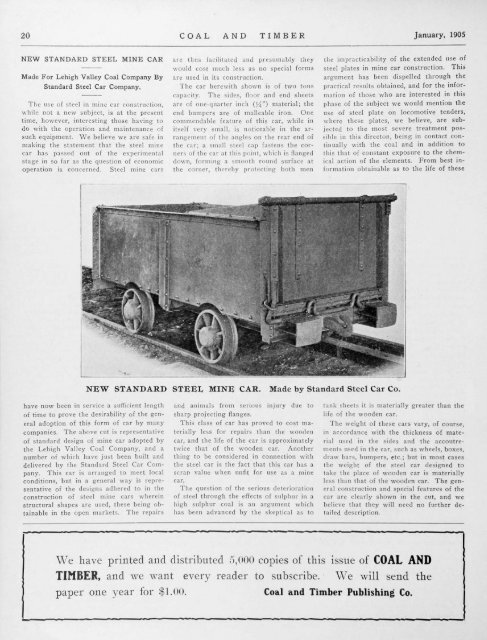You also want an ePaper? Increase the reach of your titles
YUMPU automatically turns print PDFs into web optimized ePapers that Google loves.
20 C O A L A N D T I M B E R January, 1905<br />
NEW STANDARD STEEL MINE CAR<br />
Made For Lehigh Valley Coal Company By<br />
Standard Steel Car Company.<br />
The use of steel in mine car construction,<br />
while not a new subject, is at the present<br />
time, however, interesting those having to<br />
do with the operation and maintenance of<br />
such equipment. We believe we are safe in<br />
making the statement that the steel mine<br />
car has passed out of the experimental<br />
stage in so far as the question of economic<br />
operation is concerned. Steel mine cars<br />
are thus facilitated and presumably they<br />
would cost much less as no special forms<br />
are used in its construction.<br />
The car herewith shown is of two tons<br />
capacity. The sides, floor and end sheets<br />
are of one-quarter inch (%") material; the<br />
end bumpers are of malleable iron. One<br />
commendable feature of this car, while in<br />
itself very small, is noticeable in the arrangement<br />
of the angles on the rear end of<br />
the car; a small steel cap fastens the corners<br />
of the car at this point, which is flanged<br />
down, forming a smooth round surface at<br />
the corner, thereby protecting both men<br />
the impracticability of the extended use of<br />
steel plates in mine car construction. This<br />
argument has been dispelled through the<br />
practical results obtained, and for the information<br />
of those who are interested in this<br />
phase of the subject we would mention the<br />
use of steel plate on locomotive tenders,<br />
where these plates, we believe, are subjected<br />
to the most severe treatment possible<br />
in this directon, being in contact continually<br />
with the coal and in addition to<br />
this that of constant exposure to the chemical<br />
action of the elements. From best information<br />
obtainable as to the life of these<br />
NEW STANDARD STEEL MINE CAR. Made by Standard Steel Car Co.<br />
have now been in service a sufficient length<br />
of time to prove the desirability of the general<br />
adoption of this form of car by many<br />
companies. The above cut is representative<br />
of standard design of mine car adopted by<br />
the Lehigh Valley Coal Company, and a<br />
number of which have just been built and<br />
delivered by the Standard Steel Car Company.<br />
This car is arranged to meet local<br />
conditions, but in a general way is representative<br />
of the designs adhered to in tlie<br />
construction of steel mine cars wherein<br />
structural shapes are used, these being obtainable<br />
in the open markets. The repairs<br />
and animals from serious injury due to<br />
sharp projecting flanges.<br />
This class of car has proved to cost materially<br />
less for repairs than the wooden<br />
car, and the life of the car is approximately<br />
twice that of the wooden car. Another<br />
thing to be considered in connection with<br />
the steel car is the fact that this car has a<br />
scrap value when unfit for use as a mine<br />
car.<br />
The question of the serious deterioration<br />
of steel through the effects of sulphur in a<br />
high sulphur coal is an argument which<br />
has been advanced by the skeptical as to<br />
tank sheets it is materially greater than the<br />
life of the wooden car.<br />
The weight of these cars vary, of course,<br />
in accordance with the thickness of material<br />
used in the sides and the accoutrements<br />
used in the car, such as wheels, boxes,<br />
draw bars, bumpers, etc.; but in most cases<br />
the weight of the steel car designed to<br />
take the place of wooden car is materially<br />
less than that of the wooden car. The general<br />
construction and special features of the<br />
car are clearly shown in the cut, and we<br />
believe that they will need no further detailed<br />
description.<br />
We have printed and distributed 5,000 copies of this issue of COAL AND<br />
TIMBER, and we want every reader to subscribe. We will send the<br />
paper one year for $1.00.<br />
Coal and Timber Publishing Co.
















